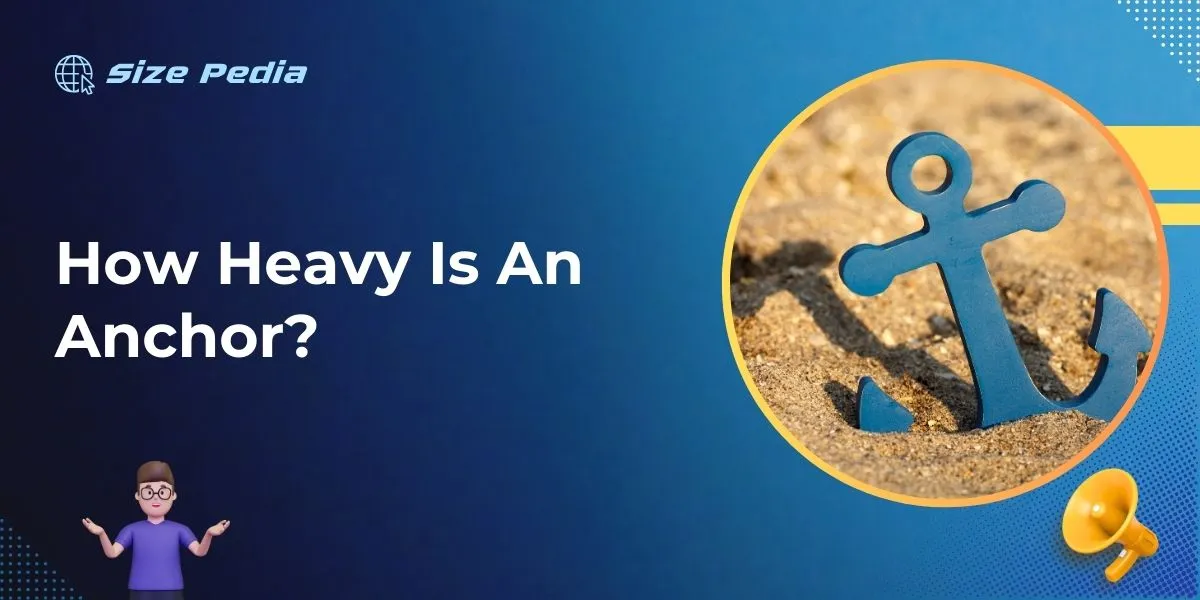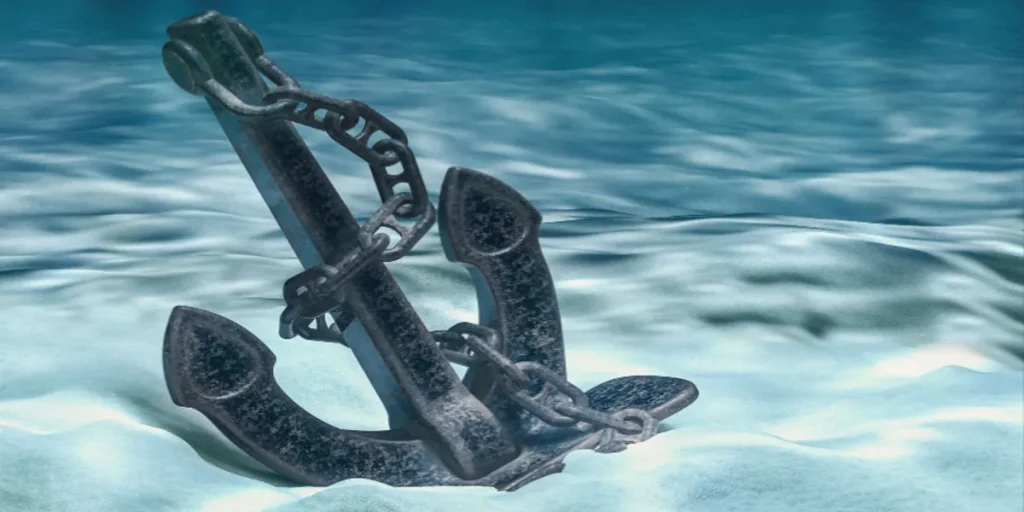An anchor’s weight varies widely, typically ranging from a few pounds to several tons. The exact mass depends on the anchor type and the vessel’s size it serves.
Anchors play a critical role in maritime navigation, providing ships with the necessary stability when mooring to a specific location on the water.
These essential maritime devices come in various shapes and sizes, each designed to function effectively in different seabed materials like mud, sand, or rock.
Ensuring proper anchorage is paramount to the safety of both vessel and crew, which directly correlates to selecting an anchor with the appropriate weight for the ship’s displacement and operation conditions.
Indeed, the importance of the right anchor weight contributes not only to the security of stationary vessels but also aids in the overall functionality in marine operations.

Role Of Anchors In Maritime Operations
Anchors Aweigh: The Role of Anchors in Maritime Operations
Anchors play a pivotal role in maritime stability. From ancient wooden stocks to modern steel designs, anchors provide essential hold for vessels against the forces of nature.
This firm grip on the seabed ensures safety and precision during maritime operations.
Historical Significance Of Anchors
Anchors have a rich history woven into maritime culture. They symbolize strength, hope, and steadfastness.
Created from simple rocks to sophisticated iron constructions, anchors have evolved remarkably over centuries. Ancient mariners relied on anchors for survival, not merely docking.
- Early anchors: Large stones, bags of sand, or wooden logs with lead-filled cavities.
- Admiralty Pattern Anchors: Known for their long arms and traditional appearance.
- Technological advancements: Led to more efficient and reliable designs.
Modern Use Across Vessels
Different ships, distinct needs—anchors today are designed for various types of vessels.
From small boats to enormous cargo ships, each anchor must match specific weight and size requirements to ensure safety and operational efficiency.
| Vessel Type | Anchor Weight (approx.) |
|---|---|
| Small Boats | 2.5 kg to 20 kg |
| Yachts | 30 kg to 300 kg |
| Cargo Ships | Over 10,000 kg |
Modern anchors: These designs often feature flukes to burrow into the seabed, providing superior hold and easy retrieval. Steel fabrication allows for a blend of strength and weight optimization important for today’s maritime operations.
- Stockless Anchor: The most common, easily stowed on modern ships.
- Plow Anchor: Good holding power, pivots to align with wind or current.
- Mushroom Anchor: Relies on its shape, suitable for long-term moorings.
Weights And Types: An Anchor’s Dimensions

The Weight and Types: An Anchor’s Dimensions are crucial for the safety and stability of any vessel.
Size Matters: From Small Boats To Large Ships
Different vessels require different anchor sizes.
Small boats may need anchors as light as 2.5 pounds.
Large ships often use massive anchors, weighing over 20 tons.
This ensures that all sizes of boats stay put, even in strong winds or currents.
Different Anchor Types And Their Weights
Several types of anchors exist, each with a unique weight and design.
- Fluke anchors, common for small boats, range from 2.5 to 80 pounds.
- Plow anchors provide strong holds, with weights between 20 to 200 pounds.
- Mushroom anchors are great for mooring, they often weigh between 10 and 2000 pounds.
- Navy anchors, known for their classic design, can weigh from 20 to several tons for larger ships.
These different types ensure that each vessel has a perfectly matched anchor for a firm hold.
Material Matters: What Anchors Are Made Of
The weight of an anchor is vital for vessel stability and safety. Not all anchors share a common build; their weights and strengths differ due to material composition.
Journeying through the evolution of these materials showcases technological advancements and insights into the material choices for today’s anchors.
The Evolution Of Anchor Materials
Anchors haven’t always been the metal giants familiar in today’s seafaring. Initially, rock and wood formed primitive anchoring systems.
Through time, advancements led to more durable and effective materials. Here is a timeline of the evolution of anchor materials:
- Stone Age: Large stones used for mooring.
- Ancient Times: Wooden anchors with lead-filled stocks.
- Iron Age: Introduction of iron anchors.
- Modern Era: Steel becomes the material of choice.
Comparing Steel And Iron
Today, the most common materials are steel and iron. Both possess unique features making them suitable for specific conditions. Let’s break down their characteristics:
| Material | Pros | Cons | Weight |
|---|---|---|---|
| Iron |
|
|
Heavy |
| Steel |
|
|
Varies |
Although iron anchors maintain a presence, steel anchors dominate modern markets. They provide increased tensile strength and resilience against the harsh marine environment, which proves crucial for long-term anchorage.
Lifting And Dropping Techniques

Understanding the right way to lift and drop anchors is crucial for safe and efficient boating.
This part of the blog post explores the techniques involved in hoisting and releasing an anchor, regardless of its weight.
Mechanics Of Deploying An Anchor
Deploying an anchor isn’t just about throwing it overboard. It’s a careful process to ensure the boat stays in place.
- Check the depth: Using a depth finder, determine the water depth to calculate the amount of chain you need.
- Prepare the anchor: Make sure it is free of tangles and the chain is ready to run smoothly.
- Approach slowly: Move towards where you want to drop the anchor, keeping your speed under control.
- Drop anchor: As the boat reaches the spot, lower the anchor and allow it to hit the bottom. Do not throw it.
- Reverse gently: As the chain extends, gently reverse to help the anchor dig into the seabed.
- Secure the anchor: Once enough chain is out, secure it and check for holding power.
Recovering An Anchor: Techniques And Tools
Lifting an anchor back onto your boat requires strength and the right tools. Be sure to use these techniques for a smooth recovery.
- Position the boat: Move directly over the anchor to reduce tension in the chain.
- Use the windlass: This tool helps lift the anchor by winding up the chain. Watch the chain carefully as it collects.
- Clear obstacles: Keep the chain free from snagging parts of the boat.
- Wash the anchor: As it surfaces, wash off any mud or debris with a deck hose.
- Secure the anchor: Once aboard, make sure the anchor is fastened properly for travel.
Note: If the anchor does not come free easily, maneuvering the boat can help release it.
Anchors Around The World: Cultural And Regional Variations
Exploring the globe reveals a wide array of anchor forms and functions. Anchors play a pivotal role in the maritime world, holding vessels steadfast against the forces of nature.
Yet their influence extends beyond their practical use. Different cultures and regions have adapted anchor designs and imbued them with symbolic meaning.
Let’s dive into the diversity of anchors and their significance across the world.
Cultural Symbolism Of Anchors
Anchors serve as powerful symbols across various cultures. In the table below, we highlight the cultural meanings assigned to the anchor in different parts of the world:
| Region | Symbolic Meaning |
|---|---|
| Europe | Hope and steadfastness |
| Asia | Safety and good luck |
| Americas | Security and stability |
| Africa | Connectedness to tradition |
Adapting Anchor Designs For Local Waters
Anchor designs are not “one size fits all.” Local waters dictate specific requirements for anchors. Here’s how regions across the globe have tailored anchor designs:
- Northern Europe: Heavy, broad-fluked anchors to grip rocky seabeds.
- Tropical Asia: Lighter, more pliable designs for coral and sand bottoms.
- Coastal Africa: Strong, grappling-style anchors for diverse coastal environments.
- Pacific Islands: Inventive reef anchors to minimize coral damage.
FAQs About the Weight of an Anchor
What Factors Affect Anchor Weight?
Anchor weight can vary based on factors such as the type of vessel, the water depth and conditions, and the anchor’s material and design. Larger ships require heavier anchors, while material choices like steel or aluminum also influence weight.
How Do Boat Anchor Sizes Compare?
Boat anchors come in various sizes, typically ranging from just a few pounds for small recreational boats to several tons for large ships. Anchor size correlates with the boat’s length and displacement, ensuring optimal holding power.
What’s The Average Weight Of A Ship’s Anchor?
On average, a ship’s anchor can weigh from about 500 pounds to over 20,000 pounds for massive vessels like tankers and container ships. The anchor must be proportionate to the ship’s size to function effectively.
Are Heavier Anchors More Effective?
Heavier anchors generally provide greater holding power, but effectiveness also depends on anchor type, seabed composition, and proper deployment. An appropriately sized anchor is crucial for safety and performance, rather than just weight alone.
Conclusion
The weight of an anchor is pivotal for maritime stability. From small boats to large vessels, choosing the right anchor weight ensures safety and dependability at sea.
Remember, it’s not just about mass; suitability to your vessel’s size and the waters you navigate are crucial.
Secure your journeys with the knowledge you’ve gained here. Sail with confidence, knowing you’re well-anchored.
Resources:
https://www.britannica.com/technology/anchor-nautical-device
